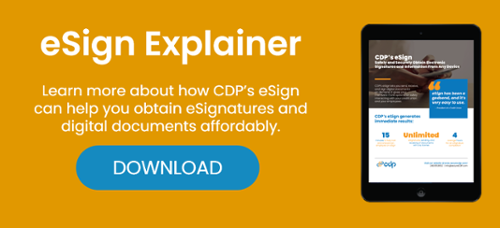Learn how to get the most out of this essential digital tool to improve the member experience, reduce inefficiencies, and bolster your overall branch digitization strategy
As credit unions and the financial industry overall (as well as most industries across the United States, for that matter) continue moving away from face-to-face customer experiences and toward virtual or hybrid business interactions, electronic signature (eSignature) technology has taken off as an essential digital tool for serving customers and getting tasks done.
But eSignature platforms do far more than the name suggests: They can help your credit union improve productivity by moving away from antiquated processes like the manual entry, storage, and logistics of paper documentation. They can also increase the safety and convenience factors for your employees and members by eliminating the need for unnecessary in-person meetings and exchanges of information.
Faster, Cheaper, Safer, Better
According to Ombud’s 2013 report, Open Research: Signature Solutions, the “adoption of eSignature solutions has empowered visionary enterprises to lead their industries by streamlining entire business workflows into end-to-end digital processes.” The report goes on to state that eSignature platforms “provide a deeper level of functionality … easily integrating into a variety of business workflows, effectively streamlining processes with robust solution capability and providing the transactional glue to connect all levels of an organization for the greatest value and ROI.”
Specific benefits include:
- Increasing the speed of transaction turnaround — Processes are interrupted, sometimes by several days to a week or more, by the need to collect physical signatures and then manually file or scan the documents back into a document management system. The Ombud report estimates that solutions that allow members to eSign documents can create an 80% average reduction in the time it takes to complete those same tasks.
- Saving money — eSignatures allow you to avoid the costs related to printing out multiple sets of documents and then sending them to members by certified mail or courier for the sole purpose of adding signatures. The Ombud report estimates that having members eSign documents can save up to $20 per document.
- Adding a layer of security — According to a recent article, “electronic signatures are safer and more secure than traditional paper documents. Not only do they contain a signature, but they also contain traceable information on who signed the document, when they signed it, and where they signed it. That's much stronger and more enforceable than your average paper-based transaction.”
- Improving customer and employee satisfaction – Your members and staff will appreciate the convenience of completing a wide array of processes online, eliminating the need for them to have to travel to your branch to do so. Providing these types of efficient end-to-end customer and employee experiences leads to increased loyalty and better long-term relationships.
How eSign from CDP Stands Out From the Crowd
While eSignature companies are rapidly gaining traction in the market, many credit union teams still don’t understand the full array of ways to utilize eSignatures in order to get the most out of them. Here, we provide a look at some of the unexpected ways to use eSignature platforms, and we also outline some of the key advantages CDP’s eSign offers in comparison to some other platforms readily available on the market.
So, what is eSign? Credit unions have traditionally used eSign as a novelty or single-use tool for obtaining the final signature in the loan process — but the platform offers far more complexity than this “one-trick pony” use case. In fact, it’s a robust solution that is available at a lower price point and with more flexibility than options from other eSignature companies, like Docusign or Adobe Sign. Therefore, leveraging the full range of benefits offered by eSignatures can have a true positive impact on member/employee experiences and process/interaction consistency, as well as your bottom line. Here are some ways to use eSignatures that may surprise you:
- It’s an effective tool that can help throughout the loan process, from A to Z — From kickoff to completion, being able to eSign documents can help you replace paper-based or “wet” signatures with an average 4-hour turnaround time; retrieve and store documents and various forms of identification; and collect and analyze vital data through the use of WebForms.
- It’s a customer/member service asset — eSign can help you simplify tasks such as opening accounts, adding a co-signer, issuing stop payments, setting up ACH transfers, collecting physical forms, and printing, signing, and re-scanning forms.
- It’s a solution for collecting data and approving changes across your branch — You can use eSign to receive and process job applications, make job offers, obtain and process W2s, make internal change requests, verify accounts payables, manage purchase orders, and more.
Learn How to Put eSign to Work for You
While the credit union culture is deeply entrenched in a long history of working with traditional paper-based processes, the time to commit to using digital eSignatures to the fullest extent has arrived.
CDP’s experienced team of digital transformation consultants can help you learn how to safely and securely digitize and eSign documents, automate manual processes, and leverage custom-fit technologies to make virtual information management easy, both for your employees and your members. Best of all, we’ll do it in a way that builds trust with your team and takes the stress out of implementation. Contact us today for information on how we can help you stay aligned with the future of the financial industry.






